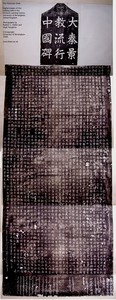Mullen, Roderic L. and Tang, Edmond and Houghton, H.A.G. (2008) The Nestorian Stele. [Image] (Unpublished)
 Image (JPEG) (Kodak Digital Camera, Graphic Converter) stele.jpg 4059Kb |
URL of Published Version: http://www.itsee.bham.ac.uk/online/stele/index.htm
Abstract
The Orchard Learning Resources Centre in the University of Birmingham possesses a rubbing of this famous monument of Chinese Christian history which was made directly from the stele in the 1920s. This is a composite photograph of this rubbing made in 2008.
This limestone stele (about ten feet high) was discovered in the sixteenth century after it had been buried and lost for about 800 years. Today the monument is housed in the "Forest of Tablets" in Shaanxi Provincial Museum (formerly a Confucian Temple) in Xi'an.
The monument was erected in 781 C.E. to commemorate the first coming of Christianity to China in the year 635 C.E. Arriving through the 5,000-mile Silk Road that linked ancient Antioch and metropolitan Changan (today Xi’an), the first Christians were essentially traders from Persia belonging to the Church of the East. They became known as “Nestorians”, a pejorative name given to them by other Christians who regarded themselves as being more orthodox.
The monument tells about the penetrating “illuminous religion” which began in Daqin (the Great Mediterranean), as opposed to Zoroastrianism, which had also come to Changan. It describes basic Christian doctrines: the “three mystery body” (trinity), the creation, the fall, the virgin birth, the holy books (of the bible), and practices such as the “holy mystery” (eucharist) and names of religious leaders, especially “Alopen” who was its Persian “missionary”. Names of priests and monks are listed in Syriac. The text ends with a hymn of praise.
The inscription also tells about the favourable treatment that the Nestorians received from Tai Zong (627-649 C.E.), the Tang emperor who himself constituted a Board of Rites (analogous to the Bureau of Religious Affairs today), approving this foreign religion. Emperor Tai Zong even granted land to the Nestorians and helped them build a monastery to which twenty-one newly ordained priests were attached.
In essence, what the stele conveys is that the followers of this foreign religion are good people who will not harm or threaten the Chinese way of life. They should be allowed to exist. Largely dependent on imperial patronage, Nestorian Christianity did not survive the several dynastic changes ofter the Tang (618-906 C.E.).
Credits
The project to digitise the rubbing was led by Dr Roderic L. Mullen and Edmond Tang. The images were prepared by Dr Mullen and Dr Hugh Houghton. We are very grateful to Dorothy Vuong of the Orchard Learning Centre. The text of this abstract has been adapted from a description by Franklin J. Woo, written in 1996.
| Type of Work: | Image |
|---|---|
| School/Faculty: | Colleges (2008 onwards) > College of Arts & Law |
| Department: | School of Philosophy, Theology and Religion |
| References: | Text of Stele in Chinese:
|
| Date: | 2008 |
| Keywords: | nestorian; stele; chinese; syriac; christianity |
| Subjects: | C Auxiliary Sciences of History > CN Inscriptions. Epigraphy. C Auxiliary Sciences of History > CC Archaeology B Philosophy. Psychology. Religion > BR Christianity D History General and Old World > DS Asia C Auxiliary Sciences of History > CB History of civilization B Philosophy. Psychology. Religion > BX Christian Denominations |
| Copyright Holders: | University of Birmingham |
| ID Code: | 755 |
|
Repository Staff Only: item control page



